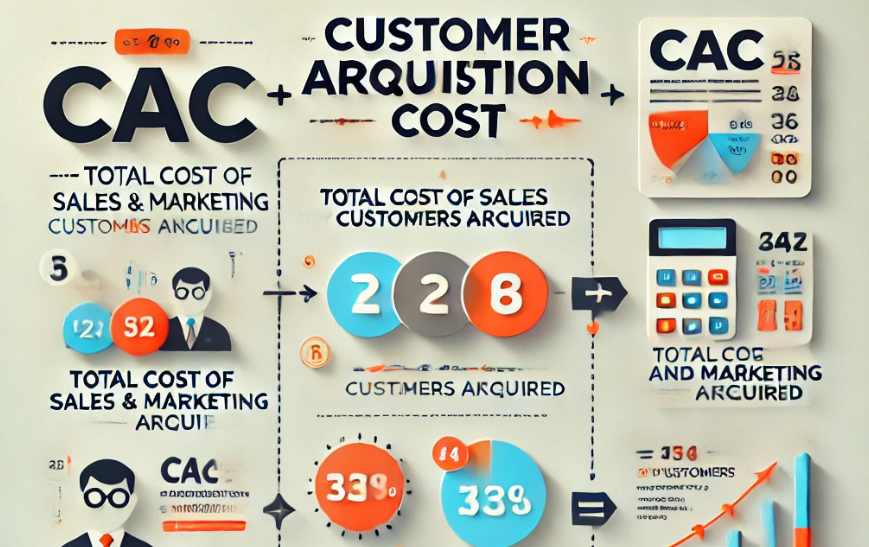In the competitive landscape of modern business, success often hinges on a company’s ability to efficiently acquire new customers. While many entrepreneurs and marketers focus on flashy marketing campaigns or innovative products, there’s a critical metric that often flies under the radar: Customer Acquisition Cost (CAC). Understanding and optimizing your CAC can be the difference between a thriving business and one that struggles to stay afloat.
What is Customer Acquisition Cost?
At its core, Customer Acquisition Cost is the total amount of money a company spends to acquire a new customer. This includes all marketing and sales expenses, from advertising budgets to salaries for sales representatives. While the concept seems straightforward, accurately calculating and interpreting CAC can be surprisingly complex.
David Chen, CEO of Acme Analytics, explains, “Many companies underestimate their true CAC by failing to account for all associated costs. It’s not just about your ad spend; you need to factor in everything from the time your team spends on sales calls to the overhead costs of your marketing department.”
To calculate CAC, use this simple formula:
CAC = Total Cost of Sales and Marketing / Number of New Customers Acquired
For example, if a company spends $100,000 on sales and marketing in a month and acquires 1,000 new customers, its CAC would be $100.
Why CAC Matters
Understanding your CAC is crucial for several reasons:
- Profitability: If your CAC exceeds the lifetime value of your customers, your business model is unsustainable.
- Marketing Efficiency: CAC helps you evaluate the effectiveness of your marketing channels and campaigns.
- Scalability: As you grow, you need to ensure that your CAC remains manageable.
- Investor Relations: For startups and growing companies, CAC is a key metric that investors scrutinize.
Industry Benchmarks: How Does Your CAC Compare?
CAC can vary widely across industries, depending on factors such as competition, product complexity, and sales cycle length. Here’s a breakdown of average CAC benchmarks for several key industries:
- E-commerce: $10 – $80
- SaaS (B2B): $250 – $1,500
- Financial Services: $200 – $800
- Healthcare: $100 – $400
- Travel: $7 – $200
- Education: $50 – $800
It’s important to note that these are general ranges, and your specific CAC may fall outside these benchmarks depending on your unique business model and market position.
Sarah Johnson, CMO of TechStart Inc., cautions, “While industry benchmarks are useful for context, don’t get too caught up in comparisons. Focus on improving your own CAC over time and ensuring it aligns with your overall business strategy.”
Factors Influencing CAC
Several key factors can impact your Customer Acquisition Cost:
- Product Complexity: More complex products often require longer sales cycles and more resources to close deals, increasing CAC.
- Target Market: B2B companies typically have higher CACs than B2C companies due to longer sales cycles and higher-touch sales processes.
- Competition: In highly competitive markets, companies may need to spend more on marketing and sales to stand out, driving up CAC.
- Marketing Channels: Different channels have varying costs and effectiveness. For example, content marketing may have a lower CAC but take longer to show results compared to paid advertising.
- Brand Recognition: Established brands often enjoy lower CACs due to existing awareness and trust.
- Economic Conditions: During economic downturns, customers may be more hesitant to make purchases, potentially increasing CAC.
The CAC-LTV Ratio: A Key to Sustainable Growth
While understanding your CAC is crucial, it’s equally important to consider your Customer’s Lifetime Value (LTV). The LTV represents the total revenue a customer is expected to generate over their entire relationship with your company.
The CAC-LTV ratio is a critical metric for assessing the health of your business model. As a general rule, aim for an LTV that’s at least 3 times your CAC. This ensures that you’re not only covering the cost of acquiring customers but also generating significant profit.
John Smith, a venture capitalist at Innovation Capital, shares, “When we evaluate startups, we look closely at the CAC-LTV ratio. A company with a strong ratio demonstrates that they have a scalable and profitable customer acquisition strategy.”
Strategies to Improve Your CAC
Regardless of your industry or current CAC, there’s always room for improvement. Here are some effective strategies to optimize your Customer Acquisition Cost:
- Refine Your Target Audience: The more precisely you can define and target your ideal customer, the more efficient your marketing spend will be.
- Optimize Marketing Channels: Regularly analyze the performance of your marketing channels and reallocate the budget to the most effective ones.
- Improve Conversion Rates: Small improvements in your conversion funnel can significantly reduce CAC. A/B tests your landing pages, email campaigns, and sales processes.
- Leverage Customer Referrals: Encourage and incentivize existing customers to refer new ones. Referral customers often have a lower CAC and higher LTV.
- Invest in Content Marketing: While it may take longer to see results, content marketing can significantly reduce CAC in the long run by attracting inbound leads.
- Streamline Sales Processes: Use automation and AI tools to make your sales team more efficient, reducing the time and resources needed to close deals.
- Focus on Customer Retention: By reducing churn, you can increase LTV, which improves your CAC-LTV ratio even if your CAC remains constant.
Case Study: How TechStart Slashed Their CAC
TechStart, a B2B SaaS company, managed to reduce its CAC by 40% over six months through a combination of strategies:
- They used data analytics to identify their most profitable customer segments and focused their marketing efforts on these groups.
- They implemented a robust content marketing strategy, creating valuable resources that attracted high-quality inbound leads.
- They optimized their sales process, using AI-powered tools to qualify leads more effectively and reduce time spent on low-probability prospects.
- They introduced a customer referral program, which quickly became their lowest-cost acquisition channel.
The Role of Pitch Deck Design Experts in Communicating CAC
For startups seeking funding, effectively communicating your CAC and related metrics is crucial. This is where Pitch Deck Design Experts can play a vital role. These professionals can help you present your CAC data in a clear, compelling manner that resonates with investors.
Mark Thompson, a pitch deck design expert, explains, “Investors see dozens of pitches every week. A well-designed deck that clearly illustrates your CAC, LTV, and growth projections can make the difference between securing funding and being overlooked.”
Conclusion: The Path to CAC Mastery
Understanding and optimizing your Customer Acquisition Cost is not a one-time task but an ongoing process. As markets evolve, competition shifts, and new technologies emerge, your CAC strategies must adapt.
By consistently monitoring your CAC, benchmarking against industry standards, and implementing optimization strategies, you can build a more efficient, profitable, and scalable business. Remember, in the world of business, it’s not just about acquiring customers—it’s about acquiring them profitably.
Whether you’re a startup founder, a marketing executive, or a business owner, make CAC a central part of your strategic discussions. Your future growth and profitability may depend on it.








